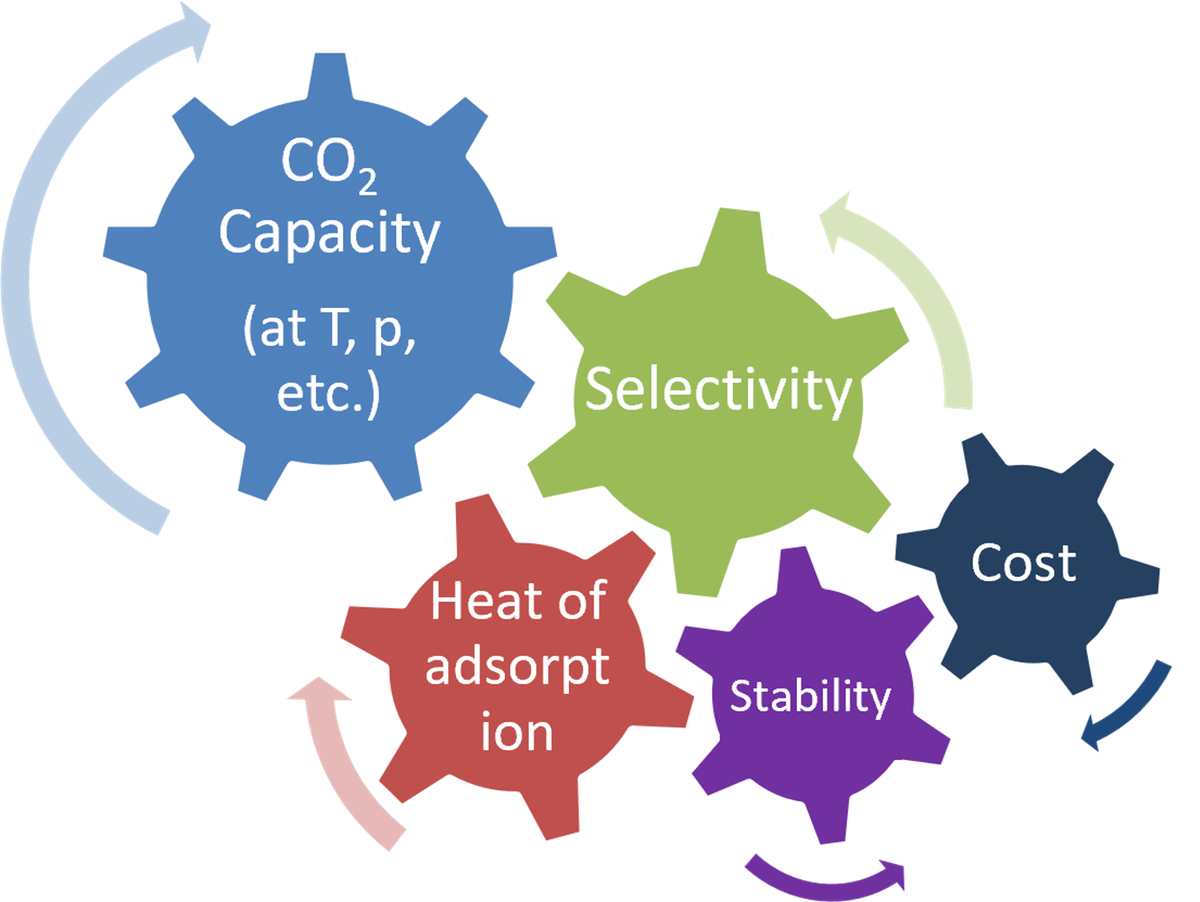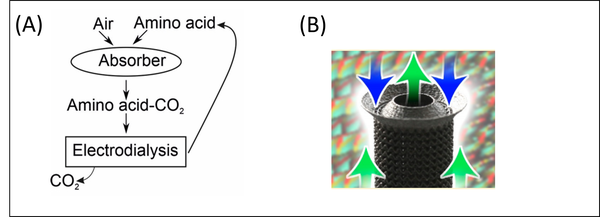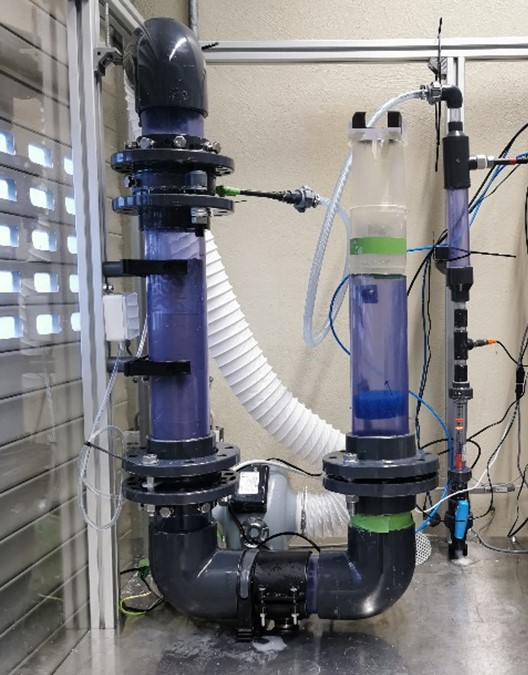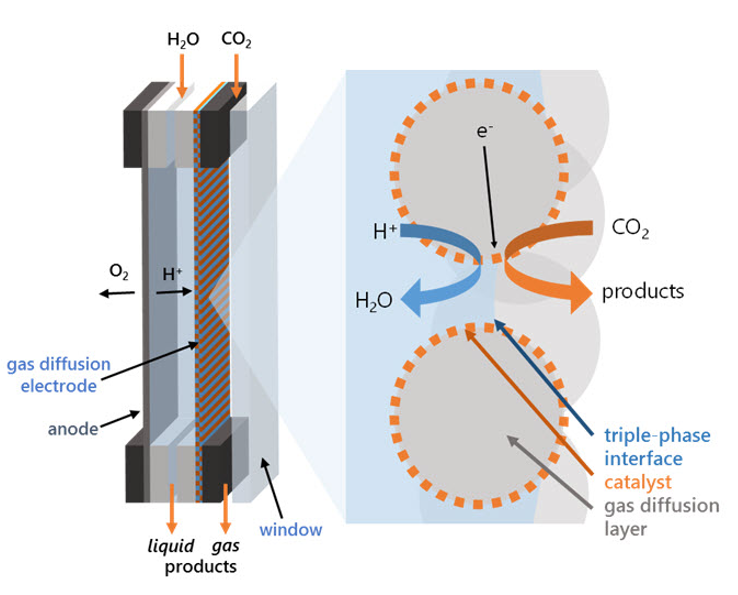Sub-Project II: Device Research
Sub project II explores and compares three technical approaches to capture CO2 from the ambient air and their scale-up. Exploration of the adsorbent path (1) includes materials synthesis, and characterization, system-level simulations, as well as system design and demonstration in a mini-plant. The membrane adsorbent path (2) studies the application of highly porous material containing functional groups working as adsorption sites. The electro swing approach (3) investigates the use of electrochemistry for the sorbent regeneration step. This approach requires only electrical energy for the regeneration step, without the need for a heat source.
Adsorbent Path:
Adsorption is currently the most frequently utilized DAC technology, although its high energy demand represents a major obstacle for scale-up. Process analysis will determine the energy demand as a function of the ambient conditions (temperature, pressure, humidity) and selected adsorbents will be investigated and tested in a mini plant.


Membrane Adsorbent Path:
With the membrane separation approach, hollow fiber membrane adsorber units with highly porous material are used. The material contains functional groups, which function as adsorption sites.

Electro Swing Approach:
The electrochemical process requires only electrical energy for the regeneration step, without the need for a heat source. Investigation of 3 concepts:
1. Amino acid

2. EMAR
3. Polymer


Industry Offers
Sub-project lead

Prof. Dr. Ralf Peters
Institute of Energy Technologies, Elektrochemische Verfahrenstechnik (IET-4), Forschungszentrum Jülich
E-Mail: ra.peters@fz-juelich.de
Partners working on this sub-project:

Forschungszentrum Jülich
- Institute of Energy Technologies, Elektrochemische Verfahrenstechnik (IET-4)
- Institute of Energy Materials and Devices, Werkstoffsynthese und Herstellungsverfahren (IMD-2)

Helmholtz-Zentrum Berlin für Materialien und Energie
- Helmholtz Young Investigators Group “Electrochemical Conversion"

Helmholtz-Zentrum Hereon
- Institut für Membranforschung

Karlsruher Institut für Technologie
- Institut für Funktionelle Grenzflächen
- Institut für Mikroverfahrenstechnik

Technische Universität Berlin
- Institut für Chemie
the scientists
Forschungszentrum Jülich
Institute of Energy Technologies, Elektrochemische Verfahrenstechnik (IET-4)
Werkstoffsynthese und Herstellungsverfahren (IMD-2)
Werkstoffsynthese und Herstellungsverfahren (IMD-2)
Werkstoffsynthese und Herstellungsverfahren (IMD-2)
Sub-Project Lead
Director
Principal Investigaton
Investigator
Werkstoffsynthese und Herstellungsverfahren (IMD-2)
Werkstoffsynthese und Herstellungsverfahren (IMD-2)
Institute of Energy Technologies, Elektrochemische Verfahrenstechnik (IET-4)
Principal Investigator
PhD Student
PhD Student
Helmholtz-Zentrum Hereon
Institute of Membrane Research, Hereon Geesthacht
Department of Microporous Polymers
Institute of Membrane Research, Hereon Geesthacht
Department of Microporous Polymers
Polymertechnologie
Mikroporöse Polymere
Investigator
Investigator
Principal Investigator
Investigator
Institute of Membrane Research
PhD Student
Helmholtz-Zentrum Berlin für Materialien und Energie
Tamino Bosse, M.Sc.
Helmholtz Young Investigators Group “Electrochemical Conversion"
Helmholtz Young Investigators Group “Electrochemical Conversion"
Principal Investigator
PhD Student
Karlsruher Institut für Technologie
Institut für Mikroverfahrenstechnik (IMVT)
Institut für Funktionelle Grenzflächen (IFG)
Institut für Funktionelle Grenzflächen (IFG)
Institut für Mikroverfahrenstechnik (IMVT)
Principal Investigator
Principal Investigator
Post-Doc
Institut für Funktionelle Grenzflächen (IFG)
Institut für Mikroverfahrenstechnik (IMVT)
PhD Student
PhD Student
PhD Student
PhD Student
Johannes Fladerer, M.Sc.
Institut für Mikroverfahrenstechnik (IMVT)
Institut für Mikroverfahrenstechnik (IMVT)
PhD Student
PhD Student
Technische Universität Berlin
Dr. Liang Liang
Institut für Chemie
Institute Head
Investigator
If you would like to be informed about DACStorE events, please send an email to dacstore-info(at)fz-juelich.de with the subject 'Mailing List' or feel free to contact us via our LinkedIn profile.
Events
Publications
Exploring Weather Impacts on Direct Air Capture Through Process and Techno-Economic Modeling
publication by A. S. Jajjawi, H. Wenzel, F. Harzendorf, J. M. Weinand, D. Stolten, R. Peters
- This article is within the framework of DACStorE Subproject II.
- Link to publication
Optimizing the Synthesis of CO2-Responsive Polymers: A Kinetic Model Approach for Scaling Up
publication by E. Pashayev, P. Georgopano, Polymers, (2025)
- This article presents a validated kinetic model for the RAFT polymerization of DMAPAm to optimize and scale up the synthesis of a CO₂-responsive diblock copolymer, PDMAPAm-b-PMMA. The model accurately predicts polymerization kinetics and properties such as molar mass and livingness, guiding the development of a scalable protocol that achieves the desired 70:30 block ratio and molecular weight (~40 kDa). This article is within the framework of DACStorE Subproject II.
- Link to publication
CO2-Responsive Copolymers for Membrane Applications, Synthesis, and Performance Evaluation
publication by E. Pashayev, P. Georgopano, Macromol. Mater. Eng., (2025)
- This paper investigates the synthesis of PDMAPM-based diblock and random copolymers and their CO₂-triggered changes in hydrophilicity for use in membrane technologies. The study compares block and random architectures, demonstrating that random copolymers show faster and more pronounced wettability changes upon CO₂ exposure, making them more suitable for responsive membrane applications. These findings provide insight into designing smart polymer membranes for CO₂-regulated separations and filtration. This article is within the framework of DACStorE Subproject II.
- Link to publication
Comparative analysis of industrialization potentials of direct air capture technologies
publication by R. Koch, D. Dittmeyer, Front. Clim., (2025)
- This paper compares four direct air carbon capture technologies—alkaline gas washing, temperature-vacuum swing adsorption, electro-swing adsorption, and accelerated weathering carbon capture—regarding their potential for industrial-scale deployment by evaluating multiple criteria including energy demand, costs, water and land use, materials, waste generation, and technology readiness levels. This paper is part of DACStorE Sub-Project II and describes how techno-economic evaluation methods help assess the scalability and operational viability of direct air capture systems.
- Link to publication
Data-Driven Innovation in Metal-Organic Frameworks Photocatalysis: Bridging Gaps for CO₂ Capture and Conversion with FAIR Principles
publication by C. Bizzarri, M. Tsotsalas, Advanced Energy and Sustainability Research (2024)
- This paper explores how metal-organic frameworks (MOFs) can be specifically engineered for CO₂ capture and photocatalytic conversion and argues that progress in this field critically depends on the adoption of standardized measurement protocols and a FAIR-compliant, open-access data infrastructure, with a particular emphasis on building a global MOF database supported by AI-driven natural language processing tools for automated data extraction. This paper is part of DACStorE Sub-Project II and shows how data-driven material design, FAIR principles, and AI-supported evaluation methods enable faster identification and optimization of MOFs for direct air capture.
- Link to publication
Criteria for effective site selection of direct air capture and storage projects
publication by F. Harzendorf, T. Markus, A. Ross, R. Valencia Cotera, C. Baust, S. Vögele, D. Taraborrelli, P. Zapp, V. A. Karydis, P. Bowyer, and D. Stolten, Environmental Research Letters (2024)
- This paper develops a comprehensive set of criteria for evaluating suitable sites for direct air carbon capture and storage (DACCS) projects, integrating not only technical aspects such as CO₂ storage and energy infrastructure but also legal, social, environmental, and economic dimensions to enable informed and balanced site selection decisions. This paper is part of DACStorE Sub-Project I, Sub-Project II, and Sub-Project III and shows how interdisciplinary site assessments and proactive regulation can establish suitable conditions for planning and scaling up direct air capture technologies.
- Link to publication
Enhancing the Quality of MOF Thin Films for Device Integration Through Machine Learning: A Case Study on HKUST-1 SURMOF Optimization
publication by L. Pilz, M. Koenig, M. Schwotzer, H. Gliemann, C. Wöll, M. Tsotsalas, Advanced Functional Materials (2024)
- This article is within the framework of DACStorE Subproject II.
- Link to publication
Sauerstoffempfindlichkeit der RAFT-Polymerisation – Eine Modellierungsstudie
publication by E. Pashayev, F. Kandelhard, P. Georgopanos, Chemie Ingenieur Technik, Volume 96, Issue 6: Special Issue: Chemische Reaktionstechnik (2024)
- This paper uses a kinetic modeling approach to investigate the oxygen sensitivity of RAFT polymerization and reveals that the rate-determining steps of inhibition are not the formation of peroxide radicals but their subsequent reactions. This paper is part of DACStorE Sub-Project II and contributes to the central research question of how modeling and control of radical polymerizations can support the reliable and reproducible production of functional polymers for CO₂ adsorptive materials.
- Link to publication
Investigating Dynamic Changes in 3D-Printed Covalent Adaptable Polymer Networks
publication by Y. Jia, C. A. Spiegel, J. Diehm, D. Zimmermann, B. Huber, H. Mutlu, M. Franzreb, M. Wilhelm, P. Théato, E. Blasco, M. Tsotsalas
- This article is within the framework of DACStorE Subproject II.
- Link to publication
CO2-Responsive Copolymers for Membrane Applications, Synthesis, and Performance Evaluation
publication by E. Pashayev, P. Georgopanos, Macromolecular Materials and Engineering (2024)
- This paper presents the development of a novel CO₂-responsive diblock copolymer (PDMAPAm-b-PMMA), synthesized via a two-step RAFT polymerization process and successfully applied as a membrane coating, where the PDMAPAm block provides CO₂ reactivity and the PMMA block contributes mechanical stability, resulting in a thin, stable, and selective membrane with enhanced permeability and selectivity for CO₂ and H₂O over N₂ and O₂. The authors show that membrane selectivity can be tuned by adjusting the polymer composition, offering a promising strategy for high-performance membranes in direct air capture applications. The study further demonstrates that these copolymers are thermally stable, processable, and reproducibly synthesizable, making them well-suited for scalable implementation. This paper is part of DACStorE Sub-Project II and contributes to the core research question of how functional polymer materials can be designed for efficient CO₂ separation from air and integrated into scalable membrane systems.
- Link to publication
4D Printing of Adaptable “Living” Materials Based on Alkoxyamine Chemistry
publication by H. B. D. Tran, C. Vazquez-Martel, S. O. Catt, Y. Jia, M. Tsotsalas, C. A. Spiegel, E. Blasco, Advanced Finctional Materials (2024)
- This article is within the framework of DACStorE Subproject II.
- Link to publication
Asymmetric Copper-Sulphur Sites Promote C-C Coupling for Selective CO2 Electroreduction to C2 Products
publication by L. Liang, L. Yang, T. Heine, A. Arinchtein, X. Wang, J. Hübner, J. Schmidt, A. Thomas, P. Strasser
- This article is within the framework of DACStorE Subproject II.
- Link to publication
Electroreduction of CO2 on Au(310)@Cu High-index Facets.
publication by L. Liang, Q. Feng, X. Wang, J. Hübner, U. Gernert, M. Heggen, L. Wu, T. Hellmann, J. P. Hofmann, and P. Strasser, Angew. Chem Int.: 2023 (62)
- This paper reports the targeted synthesis of nanostructured Au@Cu core–shell particles with well-defined high-index copper facets that exhibit significantly enhanced selectivity and efficiency for CO₂ electroreduction to methane, achieving an almost tenfold CH₄:CO product ratio compared to non-facet-controlled reference catalysts, with operando FTIR and CO stripping experiments on these specialized surfaces. This paper is part of DACStorE Sub-Project II and contributes to the central research question of how nanostructured, facet-engineered catalysts can be technically realized for selective and energy-efficient CO₂ conversion from ambient air.
- Link to publication
Functional Material Systems Enabled by Automated Data Extraction and Machine Learning
publication by P. Kalhor, N. Jung, S. Bräse, C. Wöll, P. Friederich, M. Tsotsalas, Adv. Funct. Mat. (2023)
- This paper demonstrates how automated data extraction from scientific literature combined with machine learning can significantly accelerate the development of functional material systems by transforming vast amounts of unstructured publication data into machine-readable formats and integrating them into data-driven design and optimization processes. This paper is part of DACStorE Sub-Project II and directly supports the core DACStorE mission of using computational methods and machine learning to design efficient materials for Direct Air Carbon Capture.
- Link to publication
Utilizing machine learning to optimize metal–organic framework-derived polymer membranes for gas separation
publication by L. Pilz, C. Natzeck, J. Wohlgemuth, N. Scheuermann, S. Spiegel, S. Oßwald, A. Knebel, S. Bräse, C. Wöll, M. Tsotsalas, N. Prasetya
- This article is within the framework of DACStorE Subproject II.
- Link to publication
Design of NiNC single atom catalyst layers and AEM electrolyzers for stable and efficient CO2-to-CO electrolysis: Correlating ionomer and cell performance.
publication by J. Wang, T. R. Willson, S. Brückner, D. K. Whelligan, C. Sun, L. Liang, X. Wang, P. Strasser, J. Varcoe, and W. Ju., Electrochimical Acta: 2023 (461:142613)
- This paper investigates how different ionomers influence the performance of electrocatalysts for CO₂-to-CO electrolysis. The researchers develop and test catalyst layers based on nickel–nitrogen–carbon (NiNC) single-atom catalysts in anion exchange membrane (AEM) electrolyzers, focusing on mass transport, stability, and selectivity at high current densities. The paper is part of DACStorE Sub-Project II and contributes to the central research question of how Direct Air Carbon Capture can be technically realized through robust, scalable, and cost-effective catalyst systems.
- Link to publication
Fully Automated Optimization of Robot-Based MOF Thin Film Growth via Machine Learning Approaches
publication by L. Pilz, C. Natzeck, J. Wohlgemuth, N. Scheuermann, P. G. Weidler, I. Wagner, C. Wöll, M. Tsotsalas, Advanced Materials Interfaces (2023)
- This article is within the framework of DACStorE Subproject II.
- Link to publication












